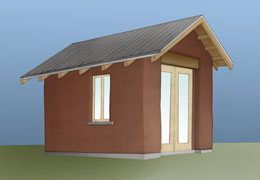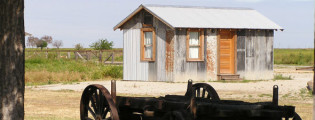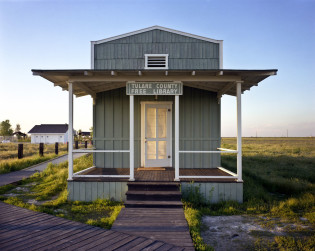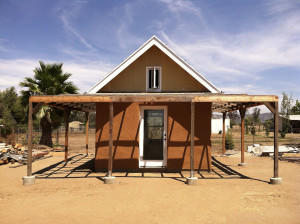 In elementary school, I was obsessed with building my own house. As an introvert in a family of extroverts, I really wanted my own separate space, snug within its own four walls and roof. It didn’t need to be large, just big enough for a bed and a desk. Having no idea how to build a house, I cut out pictures of ready-made sheds from hardware store mailers and tried to save my allowance to buy one to turn into a house in a corner of my parent’s backyard. I never could manage to save that kind of money and eventually the idea faded into the background, but I have always had a soft spot in my heart for little, bitty houses.
In elementary school, I was obsessed with building my own house. As an introvert in a family of extroverts, I really wanted my own separate space, snug within its own four walls and roof. It didn’t need to be large, just big enough for a bed and a desk. Having no idea how to build a house, I cut out pictures of ready-made sheds from hardware store mailers and tried to save my allowance to buy one to turn into a house in a corner of my parent’s backyard. I never could manage to save that kind of money and eventually the idea faded into the background, but I have always had a soft spot in my heart for little, bitty houses.
 I got some first-hand experience living tiny, since a 600 sq ft apartment in Boston was all I could afford as a recent art school graduate. Sharing walls with other apartment-dwellers just made it feel small, not separate. Later, a move across the country led me to inhabit a 400 sq ft freestanding home, a version of my childhood dream. It became clear that there are advantages and restrictions that come with living in a small space. As someone who likes to make things (and usually makes a mess in the process), having space for tools and projects was an issue. I updated my goal: needed a tiny house to live in and a workshop to make in.
I got some first-hand experience living tiny, since a 600 sq ft apartment in Boston was all I could afford as a recent art school graduate. Sharing walls with other apartment-dwellers just made it feel small, not separate. Later, a move across the country led me to inhabit a 400 sq ft freestanding home, a version of my childhood dream. It became clear that there are advantages and restrictions that come with living in a small space. As someone who likes to make things (and usually makes a mess in the process), having space for tools and projects was an issue. I updated my goal: needed a tiny house to live in and a workshop to make in.
 The growth of the Tiny House movement of the last ten years has delighted me. I have doubts about how realistic tiny houses on wheels are for everyone, but the movement has given a name to the desire for simplicity, for less, for just enough. Naming is powerful and can help people come together to change large, seemingly-unchangeable things like building regulations, as some jurisdictions have now done.
The growth of the Tiny House movement of the last ten years has delighted me. I have doubts about how realistic tiny houses on wheels are for everyone, but the movement has given a name to the desire for simplicity, for less, for just enough. Naming is powerful and can help people come together to change large, seemingly-unchangeable things like building regulations, as some jurisdictions have now done.
As I shifted my career and began to help build houses and then, later, to design and build houses, the first of the Four R’s (Reduce, Reuse, Recycle) was always on my mind. To me, one of the highest goals of design is to do more with less; to achieve the goal without wasted space or materials or resources or money.
A few years ago, I was traveling with my husband to attend a conference in Northern California and needed a place to camp. We ended up finding Colonel Allensworth State Historic Park, which turned out to be a restored tiny house ghost town: a village of small buildings in the middle of what was once somewhere but had become nowhere when the train stopped going there. It has a fascinating history and was a delightful experience that reinforced my love of the tiny.
 During the Great Recession that heralded some very slow times in construction, we decided to help a friend build a tiny straw bale building in his backyard. We designed it, poured the slab, framed the walls and roof, and held two workshops to teach people about stacking straw bales and applying clay plaster. It was a deeply satisfying experience to finally build something tiny.
During the Great Recession that heralded some very slow times in construction, we decided to help a friend build a tiny straw bale building in his backyard. We designed it, poured the slab, framed the walls and roof, and held two workshops to teach people about stacking straw bales and applying clay plaster. It was a deeply satisfying experience to finally build something tiny.
More recently, I discovered and fell in love with the Pocket Neighborhood idea. I spend time dreaming of building a collection of exquisitely designed tiny straw bale homes with excellent privacy and shared amenities, like a community room for hosting the occasional big party that doesn’t fit in a cozy home.
I am surprised how far back I can trace some of my current obsessions like natural materials and tiny buildings. I recently found out that when I started kindergarten, my teacher worried as she watched me choose to play with clay every day for months. When I finally started playing with other things as well as clay, she wrote to my parents that I seemed to have “gotten over my obsession” with clay: she turned out to be quite wrong. Her pronouncement seems now to foreshadow a life-long affair with clay. And my early fascination with buying a little shed of my own has endured and continues to inform my work today.
